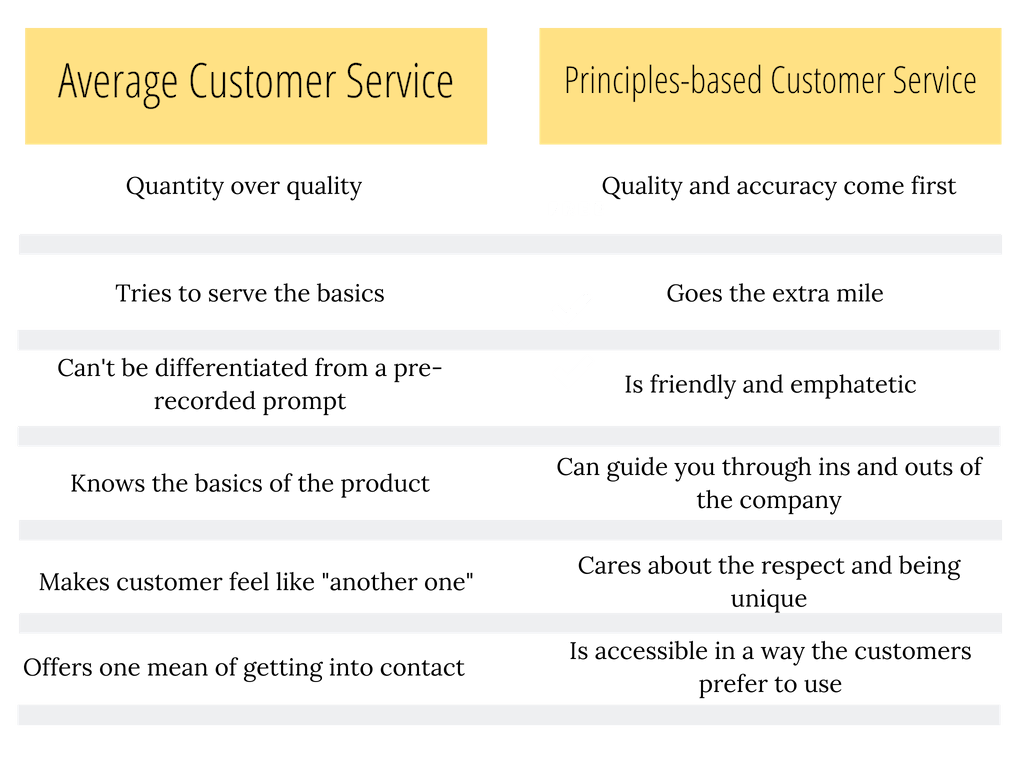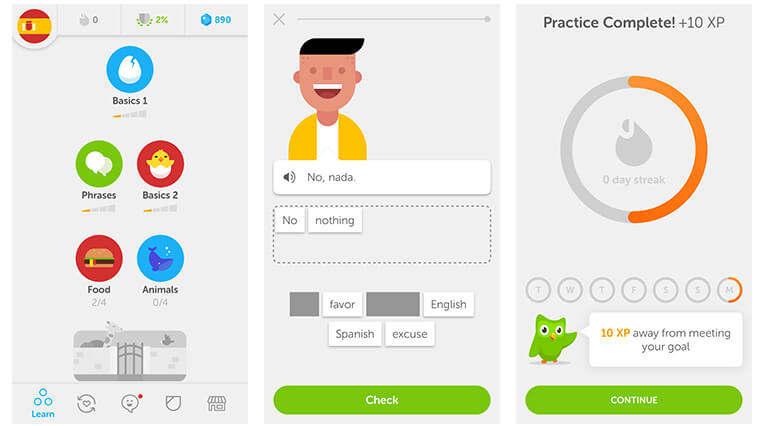15 Customer Service Principles You’re Not Aware Of

Recently, I’ve realized that respect for the principles of customer service is crucial. This is exactly what forms your opinion about product, place, employees, etc.
I can risk a statement that customer service principles are the foundation of your business reputation.
And why? Let me tell you a short story.
A couple of months ago I’ve visited the beautiful city of Lisbon along with a few of my closest fellas.
As we’ve arrived at the Humberto Delgado Airport we took an Uber to the Airbnb I booked previously. Then upon arrival, I was greeted with this heartwarming sign

The owner of the house gave us a quick tour of the apartment and provided us with useful tips and resources on how to move around the capital of Portugal. She even bought all of us tickets for public transportation in Lisbon that I was wondering how to get!
This could be just another ‘first day in the new city’ situation, but because of a couple of little details, it wasn’t. And what’s more important, I vividly remember it and will recommend this place whenever I can.
This is how powerful good customer service is.
The problem with customer service is that most companies treat it as a must. The obligation that they have to complete to satisfy their customers.
Yet, customer service is much more than that. When properly organized and applied in regards to key customer service principles it can be the main power of your business.
Even more, good customer service can work for you as a sales, marketing, and good-PR machine.
Want to see how it’s done?
Come with me.
Table of Contents:
Customer Service Principles
To make your customer service stand out you have to run it in regards to a few crucial customer service principles.
Why?
Because being average hurts. And if you execute customer service without these principles there’s no doubt that no quality customer service can be expected from you and your company.
That being said it’s crucial to understand these customer service concepts and actually apply them within your company.
How big of a change we’re talking about?
Take a look at how average customer service operates compared to the one with the core customer service principles applied:

Table with customer service principles
If anything that you see on the left reminds you of your company’s customer service do what you can to fix it as it may largely hurt your company.
To help you implement each of the principles I’m going to give you an overview of every single of these principles and in the end, you’ll find actual solutions that you can use to apply these principles.
Speed
Speed is the main quality your customers will be looking for.
Whenever someone is making a call to get an issue resolved, they want to get it done asap. And there are not here to have a nice and long conversation.
Most of the times speed and responsiveness have the highest impact on customer satisfaction. Both positive and negative, of course. Thus, the longer it takes to get an issue fixed the lower customer satisfaction becomes.
Taking all of the above into account, speed is the main principle that your customer service should be up to. And responsiveness is what your customer service team should be working on to improve it to perfection.
When it comes to responsiveness and speed, the most important metric that you should track is the first response time.
What first response time stands for is how long does it take for your customer service rep to answer the customer’s inquiry. It doesn’t mean that the issue has to be resolved. It shows how long a customer has to wait until he gets an initial response to his ticket.
The other valuable metrics are:
- Occupancy Rate
- Average Waiting Time
- Average Response Time
- Problem Resolution Time
- First Contact Resolution Ratio
Accuracy
While speed is what makes or breaks your customer service efficiency, accuracy is one of the customer service principles expected to be there.
This means that customers expect each of the information your agents provide to be true, useful, and applicable.
Yet, oftentimes speed and accuracy don’t go well together.
When customer satisfaction reps try to serve all of the clients, but the ratio of customers’ inquiries to reps available is too high then things will go wrong. In such a case, soon or later, there will be a mistake made and you’ll sacrifice accuracy to serve all of your clients.
There are a few ways to deal with this issue and to serve all customers with both speed and accuracy.
First, training. Through training your agents they’ll be able to improve their skills and better serve customers even when they’re short on time. Business owners and managers are often hesitant to provide training to their employees but they don’t realize it’s more of an investment than an expense.
Second, proper tools. Implementing software such as IVR will help your reps serve customers more accurately. Such a system is responsible for segmenting customers as they make the call but before they talk to any of the reps. This way, they get connected to the reps that – for sure – will help them resolve their issue.
You can set up an IVR in Channels in three, easy steps
1. Upload – Choose a file you want to be played to your callers when they reach you. Make sure it briefly explains which key they should click on and what action will it prompt.
2. Map – From 0 to 9, you can map all the numbers on the keypad to either prompt an internal transfer or forward the call. Choose the option and insert the appropriate phone number.
3. Tweak – Finish with the settings such as the interval between welcome message replay or times it will be played before disconnecting the caller. You can also set the working hours so they match with operating hours of your business.
Lastly, create self-serve resources. Some of the customers’ inquiries (if not the most) will replicate each other. Thus, instead of answering the same question over and over, it’d be better to provide customers with the resources that’d help them find an answer on their own. This way you relieve some of that volume from your customer service reps by redirecting a part of the traffic to passive resources that need active engagement from your team.
Clarity
Clarity is oftentimes being falsely linked to accuracy. While accuracy tells whether or not the answer you provide is true, clarity tells how understandable that message is.
In other words, while your answer might be accurate, it might turn out not to be helpful at all as the person won’t know how to apply it.
That’s why clarity is as important as accuracy.

Clarity, although often overlooked, plays a big role in how your customers perceive your service. Sadly, some of the customer service reps simply want to get the job done and provide customers with procedurally structured answers that are hard to understand.
On the other hand, you can meet customer service reps that will guide you all the way until you get an issue resolved. Plus, they will send you some helpful tips in your email.
I guess you can tell on your own which service is better and why.
To always serve your clients with clarity it’s good to set some norms and set standards regarding how the customers should be treated.
Again, most of the issues will overlap so it won’t be a problem to create a standard way to deal with them.
All in all, stress how important it’s to provide customers with accurate AND understandable answers, so they’ll be happy with what they get. Plus, there is another benefit, they won’t come back with the same issue.
Transparency
No one likes to wait.
Wow! The author must be a descendant of Albert Einstein!
Well… maybe not Einstein’s but I can tell you why this obvious fact is important when it comes to customer service principles.
Namely, it’s another obvious fact that some of your customers will have to wait until they get a response. Some due to the high volume of inquiries, some because of how complex their issue is.
Nevertheless, transparency is what can help you cope with customer satisfaction even when your customers are about to spend some time waiting.
How does it look in practice?
Well. Instead of just accepting a ticket from your customer you can send a series of emails describing how deep you’re in the process of getting an issue solved. This will create a feeling that someone is actually working on what they want to get fixed.
As you can see, transparency can be also understood as a way to give legitimacy to the time spent waiting.
Don’t ever make customers ask “What is taking so long?!”. Tell them what is taking so long, why it is taking so long, and how long will it probably take.
Accessibility
We live in the era of the Internet.
“Okay, now I’m sure the author is some kind of a genius…”
Because the Internet is a widespread area made of many independent platforms, your customer will seek many different ways on how to get into contact with your company.
Accessibility shows how easy it is to – exactly – get in touch with you.
The best way to be accessible for all of your audiences is to go omnichannel and use various types of customer service. What it means is that you should provide a way for each segment that makes up for your customer base.

That’s because some of your customers might prefer to call your customer service reps. The other will email you, while the third group would like to go on a live chat.
Of course, you won’t be able to cover each of the channels, and nor you should. The best way to be accessible is to monitor and survey your customers (and customer service teams) and find out what are their favorite ways of getting in touch with your company.
This way you’ll find out the best ways to utilize this traffic and will be able to focus solely on these channels that your customers will make use of.
A couple of days ago I’ve written an article on the best types of customer service. You’ll find there a comprehensive description of each of them, plus software that you can use to apply each of them. It perfectly tops up the article you’re reading right now. Highly recommend 👌
Empowerment
Ready to hear another well-that’s-quite-obvious fact?
We all hate having no control whatsoever. And that’s how we often feel when seeking help from a company’s customer service.
On the other hand, being in power makes us happy as we know (or at least feel) we control the situation and we’re the bosses. That’s how you should make your customers feel.
It doesn’t mean you have to name each of your customers the CEO of your company. What it does mean is you have to provide them with a way that gives them that sense of power.
One way to do it is to allow customers to rate the service they got.
Was it the best customer service you have ever received? Or was it the worst?
Tell us! Rate the agent. Give him five stars, three stars, or one start (sorry you can’t give minus one star or a dying star).

Also, provide them with a way to leave a comment regarding the service.
Some people might be hesitant to grant their customers such an ability, but in fact, people are not really eager to judge. What’s interesting is that they do become willing to leave a review only if what they receive is either the best thing they have ever got or the worst. Otherwise, they won’t bother to type a single word.
Another way to empower your customers is what I’ve described a paragraph and two earlier. Transparency and accessibility give them a feeling of – one – they can access your company however they want and – two – they know what’s going on.
Friendliness
Sadly because the way customers are served is often the “next please!” type of thing you often get a feeling of being treated as “just another one”.
For a business that relies on coming-back traffic, such an approach is a big no. If you want your customers to feel well when interacting with your customer service, you have to keep in mind friendliness.
It doesn’t mean that your customer service reps must make friends with anyone that calls them. It means being friendly and polite. It’s that simple, yet even huge companies who are supposed to know every in and out of a business world, forget about such basics.
When it comes to friendly customer service you have to remember two aspects.
First is the customer’s ego. Let’s face it. We all care about ourselves more than we care about others. Thus, we appreciate the fact whenever something is focused on us.
With that in mind, design your customer service so it is you-focused and by you, I mean the customer.
The second aspect of this principle is personality.
The personality of your customer service. Whenever a customer contacts your customer service, they don’t want to hear an automated voice or robot-like prompts.
Let your customer service reps you informal sentences (if your business type allows that) and make your customers feel like they’re actually getting served by a real human.
Efficiency
Making your customers happy and satisfied with your customer service is the main goal of this department.
Yet, no customer service is a well-working one if it doesn’t add up to the company’s profits. After all, it’s that one Excel sheet that shows whether your efforts are profitable or not. And customer service has to be no different than other teams, it has to add up.
That’s why efficiency plays a big role in customer service principles.
Fortunately, nowadays we can use solutions much different from what was available thirty, twenty, or even ten years ago.
Today, you can utilize technology to serve more customers in a shorter time with no quality loss whatsoever.
Back then you had to use the phone as the mean of communication with your clients. Now, you can utilize cloud-based phone systems such as Channels to communicate with customers over the Internet.
A couple of years ago there was no such technology as live chat or Facebook Messenger so all the messaging had to be done via email or text messages.
All in all, make use of new solutions that allow you to operate in a much more efficient way.
If you want to find out what solutions to utilize for your own business head to the 6 Types of Customer Service and How To Choose The Best article. You’ll find there a full overview of what customer service you should provide and what solutions to use to do that.
Consistency
Consistency is one of the customer service principles that will help you not to create a scenario when one of your customers is happy but the next one is so disappointed to never trust your brand again.
What I’m referring to is consistency. The consistency has to be applied across your whole customer service team including every rep and manager.
That’s because it doesn’t matter if one of your reps provides great customer service and works according to the customer service principles if another one does not. Then a part of your customers will be happy and contented while the rest may not give you the next chance.
Thus, make sure you apply the customer service principles across your whole customer service team. This will allow you to keep your efforts consistent and make sure all of your customers are happy with the service they had received.
A good practice when it comes to keeping consistency in place is creating a cheat sheet that will help your agents work according to the principles. They’ll be able to quickly check the guidelines and not forget about any of the rules.
You can create such a cheat sheet using software such as Coda or Airtable. After you’re done with the creation process you can share your doc across the team and – what’s more – allow them to comment and add their own suggestions.
Respect
When we were talking about friendliness as one of the customer service principles we did refer to the customer’s ego. It plays a big role in how you should serve each of the customers, remembering that your service should be you-centered and not company-centered.
It’s works similarly with respect.
We all want to be treated with respect and want to feel respected. It should be no different when it comes to interaction with customer service reps.
You, as a customer, want to feel like someone is actually taking care of the issue with due care. After all, you’re the customer. You paid for the service and you don’t want to feel like you’re on some free-for-all hotline.
Yet, customers are often treated like it is their fault they’re calling. But clearly, if a company shares a way to contact them, they want their customer to get in touch. That’s why you have to stress to your customer service reps that they wouldn’t have a job if it wasn’t for the customers.
All in all, treat your customer with the respect they deserve. It doesn’t mean you have to treat each caller as it was a king of Spain or a queen of Great Britain. Just be respectful and kind.
Empathy
Remember the time when a high school accident happened and you didn’t know what to do? That’s when you met up with your best friend, told him or her everything about your issue and they carefully listened to you. Even if they didn’t come up with any spectacular advice it was time worth spent as solely saying out loud what the issue is has helped you understand it and better deal with it.
Once again, customers are not your friends but still, they should feel that you actually care about their issue.
Even though – as a customer service rep – you might have heard about this problem several hundred times before, you should acknowledge the fact that it’s the first time a customer deal with this issue. Thus, he’d like you to empathize with him just as it would have been your first time.
This will highly improve how contented your customers are as they will know you actually care about what’s going on with the product, the business, and its customers.
Honesty
When we were young (Yes, I know you still look like 20…) our parents and teachers had always advised us not to lie.
Yet, from time to time it happens that we’re not really telling the truth… But it should never happen to one of your customer service reps!
Even though some people believe that when a customer service rep responds that he’s not sure when it comes to how to resolve an issue it sounds unprofessional and should never happen. But what if it happens?
Then it’s more than necessary to either route the call or get back to the customer via email or a call back when you’re sure about the resolution.
There’s no reason to prevaricate and your customers will appreciate your honesty over the fact that you didn’t know the exact answer. And it’s a much better solution compared to if you gave a wrong answer.
If your business utilizes the phone system as a customer service mean you can make use of an IVR and sort callers before they talk to actual reps. If you’re (or going to try!) Channels you can set prompts that will be played to callers and after choosing a certain tonne on a keypad they’ll be routed to the pre-set phone number.
This way you’ll limit the times when a customer calls your customer service and they don’t know what the answer is.
Knowledgeableness
Knowledgeableness as one of the customer service principles might allow you to forget about the prior one!
While I’m not saying you don’t have to be honest, there might just not be a time when your honesty will be put to the test.
Why?
If you are knowledgeable enough when it comes to the product or service there won’t be a question or an issue that you won’t be able to provide an answer to.
Customer service reps must know every little piece of your product and company so they’re eligible to help the customers.
One way to ensure your customer service team knows everything about the product is to onboard them with the product boot camp. Let it be one day, three days, or a whole week. Make them step into the shoes of their customers to better understand their perspective. Let them try out each of the features, check every option, and install available add-ons.
This way, they’ll – one – get to know your product the way they actually should. And – two – will be more comfortable in the way they serve customers.
Uniqueness
While all the other customer service principles we’re talking about are a must and could be a part of the “Customer Service Textbook: Basics” this one would be an extracurricular reference.
One thing is to make customers 100% happy, the other is to make them 101% happy.
You can achieve it by making your customer service unique. It requires you to go the extra mile and put some effort into making the whole experience memorable.
Providing additional resources, responding to social media mentions, and being always active and ready to help is what gets you those famous tweets that make your customer service a PR and growth machine.
@Zappos customer service is incredible. I asked for a replacement shoe lace and they sent me new shoes!!
— Joshgloer (@joshgloer) March 12, 2018
Remember that being unique doesn’t mean you have to invest a lot of money into surprising your customers with crazy staff.
Most of the companies just do what they’re supposed to do (or even less). Thus, you don’t have to stretch yourself that hard to offer something extra that will make your customers feel special.
Patience
This one is self-explaining, isn’t it?
Patience is what is more than expected when it comes to customer service reps. While most of the time, their patience can be tested when a customer is not really experienced with the software and it takes them long to get straight to the point.
There will be occurrences when a customer is lousy and even provokes the customer service rep.
Sooner or later it will happen and you have to take measures beforehand. The best way not to let the situation escalate the way you wouldn’t like it to do is to set rules that your reps have to follow in such a case.
If a caller passes a boundary (e.g. curses at the rep) let him quit the call or warn the caller that he or she won’t receive the service if he keeps the behavior.
After all, make sure this customer service principle is in place and stress how important it is to be patient as it doesn’t really make you do more job, but it heavily impacts the way the service (and the brand) is perceived.
Best Ways to Apply Customer Service Principles
After you got to know all the crucial customer service principles it’s important to find a way to effectively apply them to your company.
Here, you’ll find a few ways and resources that will help you do just that!
Train
Just as you flex your muscles at the gym to gain strength, you can do the same in your office to improve the way your customer service reps help your customers.
Spend some time, regularly, on training different scenarios, learning new customer service principles, and trying things out in a controlled environment.
This will make the reps feel much more confident when they actually have to serve the customers.
You can also make use of call recordings to show exactly how to act during certain types of calls and also what to avoid doing as well!
Remember to make training part of their work and not some extracurricular event that they have to attend. Business owners often think that it’s a waste of time to train their employees during work time. Don’t be that guy!
Gamify
No matter how are you going to teach your reps about customer service principles, make it as digestible as it can be.
One way to do that is by making the process a game.
Just as you’re exploring different levels of a game, collecting new achievements and badges, you can do the same when it comes to training your employees.
You can check out the famous language teaching app, Duolingo, to get to know how they’re using gamification to make the learning process easier to get through.

Guide them through different stages of advancement to let them easier assess how much did they improve. Give them rewards whenever they achieve a certain level.
All of the above will motivate your employees to further train and improve which finally will result in a better customer service offered by your company.
Assist
At some point, your customer service reps will feel confident enough to handle the toughest calls by themselves. But until that point, there’s should be a customer service manager responsible for assisting reps whenever it is necessary.
It might be stress or still limited knowledge about the product which will make any customer service rep forget what to do and how to act.
In such cases, the best solution would be to take over the call and, later on, teach them how to resolve such issues.
Supply
Nowadays, we’re capable of doing much more thanks to software advancements. And one way to apply certain customer service principles is by supplying your customer service team with proper software.
Of course, the software itself won’t make your reps more friendly or honest but it will help you achieve certain things like efficiency and accessibility.
Thus, make use of what’s available on the market and help your reps do their job with the right software.
Once again, I highly recommend you check out our newest article on 6 Types of Customer Service and Everything You Should Know About Them. You’ll find their the best pieces of software in regards to each type of customer service.
Depending on the type of your business you’ll surely find one or more technologies that will help you provide better customer service and apply the crucial customer service principles so no customer feels down.
Use Phone System for Your Customer Service
If you’re ready to implement a phone system as your solution for customer service, Channels is your software to go. It will help you achieve all of the customer service principles and satisfy even the toughest customers.
Right now, you can try it out with a 7-day free trial during which you’ll get full access to the software, a free phone number, and a few $$$ so you can fully test it out!
Make your customer service great again!
We’ve come to an end.
I hope this journey was as exciting for you as it was for me.
Now you’re ready to make your customer service truly on-point with the 15 crucial customer service principles that we’ve described.
Remember, that your customer service should never be about your company and always about the customer. And that’s what you should stress to your customer service reps.
If your company focuses on the customers and becomes customer-centric things should go well. After all, no company would be present if there were no customers.
I’ll leave you with that in mind and hopefully, we’ll meet in a few days to publish fresh blog posts every few days!



